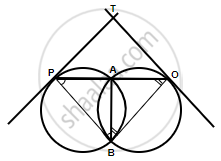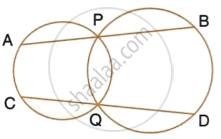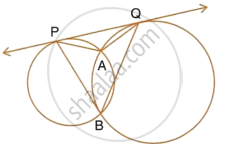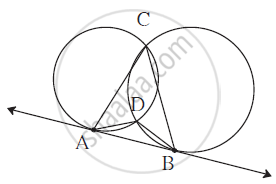Advertisements
Advertisements
Question
Two circles intersect each other at points A and B. A straight line PAQ cuts the circles at P and Q. If the tangents at P and Q intersect at point T; show that the points P, B, Q and T are concyclic.
Solution

Join AB, PB and BQ
TP is the tangent and PA is a chord
∴ ∠TPA = ∠ABP ...(i) (Angles in alternate segment)
Similarly,
∠TQA = ∠ABQ ...(ii)
Adding (i) and (ii)
∠TPA + ∠TQA = ∠ABP + ∠ABQ
But, ΔPTQ,
∠TPA + ∠TQA + ∠PTQ = 180°
`=>` ∠PBQ = 180° – ∠PTQ
`=>` ∠PBQ + ∠PTQ = 180°
But they are the opposite angles of the quadrilateral
Therefore, PBQT are cyclic.
Hence, P, B, Q and T are concyclic.
APPEARS IN
RELATED QUESTIONS
Two circle touch each other internally. Show that the tangents drawn to the two circles from any point on the common tangent are equal in length.
Two circles of radii 5 cm and 3 cm are concentric. Calculate the length of a chord of the outer circle which touches the inner.
In the given figure, two circles touch each other externally at point P. AB is the direct common tangent of these circles. Prove that :

- tangent at point P bisects AB,
- angles APB = 90°.
Two parallel tangents of a circle meet a third tangent at points P and Q. Prove that PQ subtends a right angle at the centre.
Two circle with centres O and O' are drawn to intersect each other at points A and B. Centre O of one circle lies on the circumference of the other circle and CD is drawn tangent to the circle with centre O' at A. Prove that OA bisects angle BAC.

Two circles intersect at P and Q. Through P, a straight line APB is drawn to meet the circles in A and B. Through Q, a straight line is drawn to meet the circles at C and D. Prove that AC is parallel to BD.

Two circles intersect each other at points A and B. Their common tangent touches the circles at points P and Q as shown in the figure. Show that the angles PAQ and PBQ are supplementary.

Two circles intersect each other at points C and D. Their common tangent AB touches the circles at point A and B. Prove that :
∠ ADB + ∠ ACB = 180°

In which qudrant does point A(-3, 2) lie?
On which axis does point B(12, 0) lie?
P and Q are the centre of circles of radius 9 cm and 2 cm respectively; PQ = 17 cm. R is the centre of circle of radius x cm, which touches the above circles externally, given that ∠ PRQ = 90°. Write an equation in x and solve it.
